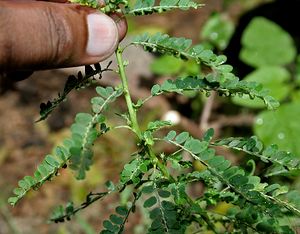Note: This is a project under development. The articles on this wiki are just being initiated and broadly incomplete. You can Help creating new pages.
Difference between revisions of "Phyllanthus amarus - Bhuamlaki"
(→Uses) |
|||
| Line 4: | Line 4: | ||
==Uses== | ==Uses== | ||
| − | {{Uses|Diarrhea}}, {{Uses| | + | {{Uses|Diarrhea}}, {{Uses|Cold}}, {{Uses|Fevers}}, {{Uses|Gynecology}}, {{Uses|Arthritis}}, {{Uses|Diabetes}}, {{Uses|Backache}}. |
==Parts Used== | ==Parts Used== | ||
Revision as of 16:05, 23 January 2019
Phyllanthus amarus is widely used as a medicinal plant in Ayurvedic medicine. A suppository of the leaf paste is applied to the vagina to treat absence of menstruation and polyps. Leaf sap, mixed with palm oil or not, is applied as ear drops to treat otitis and applied to abscesses, sores and wounds.
Contents
- 1 Uses
- 2 Parts Used
- 3 Chemical Composition
- 4 Common names
- 5 Properties
- 6 Habit
- 7 Identification
- 8 List of Ayurvedic medicine in which the herb is used
- 9 Where to get the saplings
- 10 Mode of Propagation
- 11 How to plant/cultivate
- 12 Commonly seen growing in areas
- 13 Photo Gallery
- 14 References
- 15 External Links
Uses
Diarrhea, Cold, Fevers, Gynecology, Arthritis, Diabetes, Backache.
Parts Used
Chemical Composition
Numerous phytochemicals such as alkaloids, flavonoids, tannins, lignans and polyphenolics as well as tetracyclic triterpenoids have identified and isolated from the plant (Foo and Wong, 1992; Foo, 1993 and 1995; Leite et al., 2006; Londhe et al., 2009; Moronkola et al., 2009). Based on the numerous folkloric applications of Phyllanthus amarus that have not been scientifically proven, this study aimed at identifying the chemical composition of the non-polar and polar extracts of P[1]
Common names
| Language | Common name |
|---|---|
| Kannada | Nela nelli |
| Hindi | |
| Malayalam | Keezhar nelli |
| Tamil | Keezha nelli |
| Telugu | Neala usiri |
| Marathi | NA |
| Gujarathi | NA |
| Punjabi | NA |
| Kashmiri | NA |
| Sanskrit | Bhumyamalaki |
| English |
Properties
Reference: Dravya - Substance, Rasa - Taste, Guna - Qualities, Veerya - Potency, Vipaka - Post-digesion effect, Karma - Pharmacological activity, Prabhava - Therepeutics.
Dravya
Rasa
Guna
Veerya
Vipaka
Karma
Prabhava
Habit
Identification
Leaf
| Kind | Shape | Feature |
|---|---|---|
| alternate | elliptic to oblong | Each branch has 12-32 leaves. The leaves are elliptic to oblong, to 1.5 cm (usually smaller), with an entire margin and with a rounded or apiculate leaf apex |
Flower
| Type | Size | Color and composition | Stamen | More information |
|---|---|---|---|---|
| very small cymes | bright yellow | 3 stamens | The 1st and 2nd cymes nearest the man stem have only staminate flowers. The remaining cymes on the side branches have staminate and carpellate flowers. The staminate flowers have 5 or 6 fused sepals in the calyx and 3 stamens. Carpellate flowers have 5 or 6 fused |
Fruit
| Type | Size | Mass | Appearance | Seeds | More information |
|---|---|---|---|---|---|
| short legume | 7.5–11 cm long, 1.5 cm broad | A dry capsule, dehiscent, vertically muriculate. Fruiting throughout the year | seeds 6 | {{{5}}} | {{{6}}} |
Other features
List of Ayurvedic medicine in which the herb is used
- Vishatinduka Taila as root juice extract
Where to get the saplings
Mode of Propagation
How to plant/cultivate
Requires a sunny position. Sandy loam and black soils with a pH of 7.5 - 8 are considered best[3]
Commonly seen growing in areas
Tropical region, Subtropical region, Drained sandy-loam soil.
Photo Gallery
References
External Links
- Ayurvedic Herbs known to be helpful to treat Diarrhea
- Ayurvedic Herbs known to be helpful to treat Cold
- Ayurvedic Herbs known to be helpful to treat Fevers
- Ayurvedic Herbs known to be helpful to treat Gynecology
- Ayurvedic Herbs known to be helpful to treat Arthritis
- Ayurvedic Herbs known to be helpful to treat Diabetes
- Ayurvedic Herbs known to be helpful to treat Backache
- Herbs with Whole plant used in medicine
- Herbs with common name in Kannada
- Herbs with common name in Malayalam
- Herbs with common name in Tamil
- Herbs with common name in Telugu
- Herbs with common name in Sanskrit
- Habit - Annual herb
- Index of Plants which can be propagated by Seeds
- Herbs that are commonly seen in the region of Tropical region
- Herbs that are commonly seen in the region of Subtropical region
- Herbs that are commonly seen in the region of Drained sandy-loam soil
- Herbs


